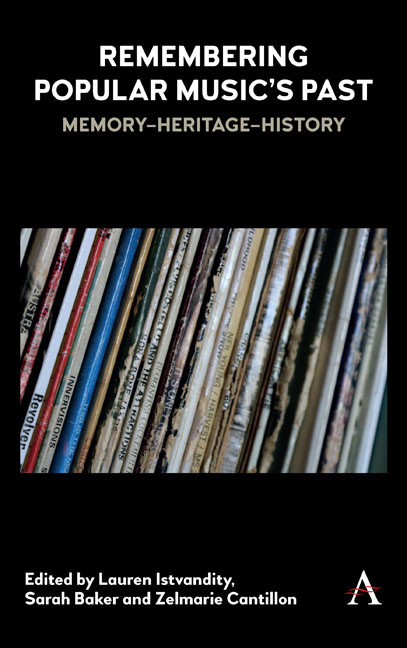Book contents
- Frontmatter
- Contents
- List of Figures
- Acknowledgements
- Chapter 1 The Precarity of Memory, Heritage and History in Remembering Popular Music's Past
- Part I MEMORY
- Part II HERITAGE
- Chapter 7 Mark II: Reworking the Heritage B(r)and
- Chapter 8 The Continually Precarious State of the Musical Object
- Chapter 9 Showing Off: Taking Popular Music Research into the Museum
- Chapter 10 Preserving Icelandic Popular Music Heritage: Issues of Collection, Access and Representation
- Chapter 11 Questioning the Future of Popular Music Heritage in the Age of Platform Capitalism
- Part III HISTORY
- List of Contributors
- Index
Chapter 9 - Showing Off: Taking Popular Music Research into the Museum
from Part II - HERITAGE
Published online by Cambridge University Press: 09 July 2019
- Frontmatter
- Contents
- List of Figures
- Acknowledgements
- Chapter 1 The Precarity of Memory, Heritage and History in Remembering Popular Music's Past
- Part I MEMORY
- Part II HERITAGE
- Chapter 7 Mark II: Reworking the Heritage B(r)and
- Chapter 8 The Continually Precarious State of the Musical Object
- Chapter 9 Showing Off: Taking Popular Music Research into the Museum
- Chapter 10 Preserving Icelandic Popular Music Heritage: Issues of Collection, Access and Representation
- Chapter 11 Questioning the Future of Popular Music Heritage in the Age of Platform Capitalism
- Part III HISTORY
- List of Contributors
- Index
Summary
Curatorship, Authoring, Staging
In 1994, Sydney's prestigious Powerhouse Museum staged a major exhibition on popular music in Australia, Real Wild Child: Australian Rock Music Then and Now. Although regarded internally by some as being a risky departure from that museum's more established excursions into orthodox social history, the exhibition turned out to be well attended, and was soon seen (in the larger museum sector) as a great success (Mitchell 1996, 207). Since then, popular music and, more generally, themes concerning popular culture have been recurring and increasing presences in Australian museums and public galleries.
Music-centred pop culture retrospectives have also become regular fare on public television –particularly the public broadcast ABC and SBS networks –as well as on private networks. Popular music in Australia has gone from being only minimally historicized to quite extensively historicized, and has gone from being extraneous to the business of large-scale official cultural institutions to being considered central, or at least as central as any other topic. The impulse to historicize Australian popular music and locate it in relation to formulations of national identity and cultural heritage is now widespread, and largely unquestioned. But this is a recent development in Australia, dating from that exhibition at the Powerhouse.
More recently, museums and galleries (as well as large public broadcasters) in Australia have been in turbulent flux. The rise of digital communications and social media has roughly coincided with pronounced shifts in the ideologies of governance within what might be called ‘public culture’ sectors. Over the past decade in particular, major public broadcasters, and nearly the entire government-funded museum and gallery sector, have been subject to waves of hostile restructures and stringent budget cuts by state and federal overseers (Morris 2018). The processes governing public cultural production have altered so rapidly and profoundly that the long-standing practices and philosophies of just a decade or two ago now seem almost utopian.
The remarks that follow are an attempt to navigate those large separate and protracted events: the dramatic tightening across the publicly funded culture sectors, and a broad, growing awareness of cultural retrospectivity, which in turn is fundamentally shaped and accelerated by digital communication flows.
- Type
- Chapter
- Information
- Remembering Popular Music's PastMemory-Heritage-History, pp. 115 - 130Publisher: Anthem PressPrint publication year: 2019

